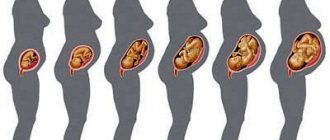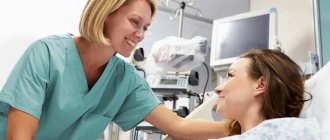What is a polyp
Why a uterine polyp is dangerous is of interest to many women. It should be understood that neoplasms vary in size, which can vary from 1-2 mm to 10-80 mm. As a rule, polyps are oval or round in shape and have a wide base or stalk that connects them to the endometrium. According to the nature of the disease, single polyps or multiple polyposis are distinguished. The pathology is dangerous due to possible complications:
- intrauterine bleeding;
- infertility;
- miscarriage;
- high risk of degeneration into cancer in women over 45 years of age.
Complications with the wrong approach
Complications after hysteroscopy can occur, as a rule, due to a violation of the technique of performing the procedure, which can be carried out by unqualified specialists. This method of treatment can be called the safest, therefore, the onset of complications in the future depends mainly on the doctor. Surgeries to remove a polyp or fibromatous node are among those after which complications may occur. This is mainly uterine bleeding. In this case, the discharge is profuse and lasts more than 48 hours.
Inflammation of the uterine mucosa, namely endometritis, occurs in the absence of compliance with antiseptic rules after the procedure. In this case, the body temperature rises, pain appears in the lower abdomen, and the discharge becomes purulent. Treatment in this case is the use of antibacterial, painkillers, antihistamines and immunomodulatory drugs. Detoxification therapy is also indicated.
All studies, diagnostics and surgical interventions are carried out only after prior consultation with a doctor.
You can sign up for a consultation and find out more from the administrator by calling +7 (495) 356-30-03.
Etiology
Treatment of cervical polyps begins with searching for the causes of the pathology. This makes it possible to develop more effective therapy and prevent subsequent relapses. Among the risk factors:
- hormonal imbalances (excess estrogen and deficiency of progesterone in the second phase of the female cycle);
- endometriosis;
- long-term use of sex hormones or glucocorticosteroids;
- obesity;
- operations on the uterus (curettage, abortion, miscarriage);
- partial removal of the placenta after childbirth (the so-called placental polyp);
- an intrauterine device that stays in place for a long time;
- chronic inflammatory processes in the uterus, ovaries, and cervix.
Hysteroscopy of the uterus: reviews
Regarding hysteroscopy, reviews from patients are mostly positive. For example, a significant part of them note that the procedure turned out to be absolutely painless. Moreover, they did not require painkillers either during or after hysteroscopy.
Some women who underwent hysteroscopy of the uterus under general anesthesia reported discomfort after the procedure. However, as experts explain, in order to avoid negative feelings, you should not drink or eat before anesthesia. Then there will be no nausea and headaches after hysteroscopy.
Finally, it should be noted that hysteroscopy of the uterus is a difficult and serious procedure, which can only be entrusted to experienced doctors. It is important to first pass all the necessary tests, as well as a smear from the vaginal passages for microflora. Only a qualified specialist knows how to perform hysteroscopy without negative consequences.
Types of pathology
The types of polyps in the uterus are differentiated by structure and content.
- Fibrous form. The formations consist of elements of connective tissue of a fibrous nature. Sometimes collagen fibers may be present.
- Glandular fibrous polyps. The neoplasm contains irregularly shaped glands. This group of polyps is characterized by circulatory disorders and inflammatory processes.
- Adenomatous formations. They are usually provoked by focal adenomatosis. They have a high risk of cancer transformation.
Who can benefit from hysteroscopy?
Sometimes a woman may be concerned about why she cannot get pregnant. Or you need to find out if there is a tumor or inflammation in the uterus. Then you can “look at the problem from the inside” - using hysteroscopy. We are talking about the method of studying the inner surface of the uterus with the doctor at the Expert Clinic Irkutsk, Radmila Borisovna Prokhorenko.
— Radmila Borisovna, what is hysteroscopy?
“Hystera” means “uterus” in Greek, “scopeo” means “to look at.” This is a method of minimally invasive examination of the inner surface of the uterus using optical systems. A hysteroscope (a device equipped with an LED and a miniature video camera) is inserted into the uterine cavity through the cervical canal. It helps to assess the condition of the uterine cavity and identify intrauterine pathology.
— So it turns out that this is a diagnostic method? Or can it be used to treat?
— Hysteroscopy combines both. As a diagnostic method, it allows you to identify pathology of the uterine cavity, which can be eliminated immediately during the procedure.
— When should hysteroscopy be performed?
— In cases where it is necessary to identify any uterine pathology: anomalies of the uterus, synechia (fusion), septum in the uterine cavity, polyps, submucous uterine fibroids, endometriosis, hyperplasia and endometrial cancer. It is also performed when it is necessary to remove a foreign body (intrauterine contraceptive device, ligatures).
— Is it possible to combine hysteroscopy with other treatment methods, for example, with laparoscopy?
— Yes, you can combine these two methods if it is necessary to simultaneously perform surgery in the abdominal cavity and in the uterine cavity. The operations are often combined when patients are being examined for infertility problems. It is also advisable to perform them together also because laparoscopy and hysteroscopy can be done under the same anesthesia.
— Is hysteroscopy a painless procedure? How does the patient feel during it?
— There is a so-called office hysteroscopy, which can be performed on an outpatient basis: a thin endoscope with a diameter of 4-5 mm is inserted, which does not require dilation of the cervical canal. They can examine the uterine cavity without anesthesia, or using local anesthesia. But hysteroresectoscopy is performed under intravenous anesthesia: it requires expansion of the cervical canal, and it is also necessary to perform tissue resection. When using anesthesia, the woman falls asleep comfortably and does not experience any discomfort.
— Do I need any preparation for hysteroscopy?
— This procedure does not require special preparation. It is necessary that the patient does not take any food or water 4 hours before the procedure. Sometimes we recommend a cleansing enema if there are problems with stool.
— How long does the procedure take?
- It's always individual. For diagnostic hysteroscopy – five minutes. In most cases, about ten minutes. In complex cases, for example, when removing a large submucous myomatous node (i.e. located under the uterine mucosa), the procedure can last from thirty minutes to an hour.
— How long does the recovery period last in most cases?
— In general, the procedure is quite comfortable. After hysteroscopy, a woman does not lose her ability to work. Sometimes there is a slight aching pain in the lower abdomen, since during hysteroscopy a saline solution is injected into the uterine cavity, which is thrown through the fallopian tubes into the abdominal cavity. The solution slightly irritates the peritoneum, and until this liquid is absorbed, the woman sometimes feels heaviness and discomfort. Discharge from the genital tract after hysteroscopy depends on the extent of the surgical intervention. If the procedure is diagnostic, scanty bloody discharge will be observed for several days. If the myomatous node was removed, the discharge will be more abundant.
— What should not be done after hysteroscopy?
— It is not recommended to take hot baths, visit baths, saunas. Until the discharge from the genital tract ends, you can only wash in the shower. It is worth refraining from sexual activity, physical activity, and not using tampons. The duration depends on the pathology being eliminated: these actions should be avoided from two weeks to a month.
— On what day of the cycle is it recommended to perform hysteroscopy? Is it done during menstruation?
— Routine hysteroscopy is not performed during menstruation, since the sloughing endometrium interferes with normal vision. The best time for the procedure is the first half of the cycle. After the uterine mucosa is shed, pathological structures are clearly visible. If a woman presents with infertility problems, it is recommended to conduct an examination on days 7-11 of the cycle.
In the presence of bloody discharge, hysteroscopy is performed only for emergency indications, for example, during bleeding accompanying endometrial hyperplasia.
— Why is hysteroscopy done before the in vitro fertilization (IVF) procedure?
— Before IVF, it is needed to identify and eliminate intrauterine pathology, which cannot always be detected, for example, by ultrasound. When performing hysteroscopy, you can, for example, see adhesions that will prevent the attachment of the fertilized egg, foci of endometriosis, and evaluate the endometrium. The so-called scratching effect is described, when due to microtrauma of the endometrium during hysteroscopy, the percentage of the likelihood of embryos attaching to the uterine mucosa increases.
— Radmila Borisovna, can complications arise during or after this procedure?
— After the operation, any general surgical complications may develop, including bleeding, infection, thromboembolism.
Infectious complications may occur days or weeks after surgery. Treatment of an infectious complication can be carried out with medication or surgery. To avoid complications, we prescribe preventive antibiotic therapy.
During the operation, injuries and ruptures of the cervix, perforation (perforation) of the uterus with a gynecological instrument may occur, which sometimes requires additional emergency surgical intervention.
You can make an appointment with a gynecologist at the Expert Clinic Irkutsk here ATTENTION: the service is not available in all cities
The editors recommend: Myoma: to remove or not? When will myomectomy help? A mystery disease: what is endometriosis?
For reference:
Prokhorenko Radmila Borisovna
1996 – Graduate of IGMU with a degree in General Medicine.
1998 – completed internship (“Obstetrics and Gynecology”).
2017 – NTsAGiP im. IN AND. Kulakov of the Russian Ministry of Health, training as part of the implementation of a model for developing the basic principles of continuous medical education.
2017 – training course on laparoscopy.
2017, 2021 – advanced training courses in several areas.
Currently, he is the head of the gynecological department, obstetrician-gynecologist at Clinic Expert, Irkutsk. Receives at the address: Irkutsk, st. Kozhova, 9A.
Symptoms
How to treat polyps in the uterus depends on their type and stage of the disease. Timely consultation with a doctor can significantly simplify treatment. Below are the symptoms that a woman should definitely pay attention to:
- nagging cramping pain in the lower abdomen;
- long or heavy periods;
- menstrual irregularities;
- infertility;
- clear or yellowish discharge with an unpleasant odor;
- discomfort during sexual intercourse;
- bleeding after sexual intercourse or during physical activity.
Recommendations for the recovery period
Normally, after hysteroscopy, for two days a woman may be bothered by slight bleeding from the vagina and mild, moderate pain in the lower abdomen. To alleviate the condition, the patient is allowed to take a painkiller. If the pain increases, you should immediately consult a doctor. This may be a sign of developing complications.
To speed up recovery, experts recommend:
- follow all doctor’s orders, in particular, do not refuse to take antibiotics to prevent the development of infections;
- exclude the use of vaginal suppositories, tablets and creams;
- carefully observe personal hygiene;
- refrain from intense physical activity;
- Maintain a balanced diet to prevent constipation.
In general, the likelihood of complications with hysteroscopy in Nizhny Novgorod is much lower than with other invasive interventions. But it should be resorted to only when other diagnostic methods (transabdominal and transvaginal ultrasound, aspiration biopsy of the myometrium) turned out to be uninformative.
Therapy
Treatment of a polyp in the uterus without surgery is possible if the formation is small. In this case, the doctor will prescribe constant monitoring of the growth and hormonal therapy. It is also important in treatment to eliminate factors that provoke polyp growth.
More often, doctors insist on removing the polyp. The intervention is carried out under local or general anesthesia. The procedure is known as hysteroscopy and is performed using a special optical instrument called a hysteroscope. It is a long thin tube through which instruments and a video camera are inserted. Access to polyps is organized through the cervix. A small amount of liquid is injected into the organ cavity, which allows the walls to straighten and improve visibility.
The procedure is carried out under visual control: the uterine cavity is displayed on the monitor, due to this, high accuracy of the operation is achieved. The whole procedure takes about 20-40 minutes. Hysteroscopy of a uterine polyp does not require hospitalization and the woman can return home in the evening. In order for the procedure to be successful and with a minimum number of complications, it is important to follow the recommendations after hysteroscopy.
Recovery after hysteroscopy
After the operation, the patient must undergo a course of hormonal therapy, drink a vitamin complex and medications that include iron. Complete restoration of menstruation occurs within one and a half months.
In addition, a separate course of treatment is prescribed for each patient in accordance with the characteristics of the body and the course of the disease. The severity of the disease is the determining factor in determining a competent recovery course.
In addition, the main thing in restoring the body after hysteroscopy is proper rest and good sleep. The more comfortable the environment is for a woman, the better. Equally important are activities that bring pleasure, a favorite hobby or pleasant activities around the house. Full recovery of the body will be accelerated by proper nutrition and daily walks in the fresh air.
How should you prepare for hysteroscopy? Before hysteroscopy
Before performing hysteroscopy, you must undergo the following tests:
- General clinical blood and urine tests;
- Biochemistry, coaglogram;
- Wasserman reaction, research for HIV, hepatitis B, C;
- Bacterioscopic examination of vaginal discharge;
- ECG;
- Fluorography of the chest.
In the case of a proposed combination of hysteroscopy with laparoscopy, or if an extensive and lengthy intrauterine operation is intended, the tests and preparation should be the same as for laparoscopic surgery.
There is no special preparation on the eve of the operation; a cleansing enema is performed according to indications. On the day of surgery, the patient does not eat or drink, which is important for general short-term anesthesia.
On what day of the cycle is hysteroscopy performed? Hysteroscopy day of cycle (menstruation).
- In cases of suspected organic pathology (uterine fibroids, endometriosis, etc.) in women of reproductive age, the study is carried out in the early follicular phase of the menstrual cycle (on days 7, 8, 9) to improve visibility while the endometrium is thin and minimally vascularized.
- In emergency situations and for the purpose of functional assessment of the endometrium, the day of the menstrual cycle is not of fundamental importance. The main thing is that the hysteroscopy does not coincide with critical days.
Which clinics perform hysteroscopy?
Hysteroscopy is rarely performed on an outpatient basis. Basically, this is the so-called office or purely diagnostic hysteroscopy.
If the task is to carry out any manipulations in the uterine cavity, hysteroscopy should be carried out in a small operating room and preferably in a hospital. This is more informative and safer for the patient. In recent years, hysteroscopy is often combined with laparoscopy. The recommendation is to do hysteroscopy in specialized gynecological clinics.
What anesthesia is used?
Surgical hysteroscopy must be performed under anesthesia. The method of choice is general short-term intravenous anesthesia.









